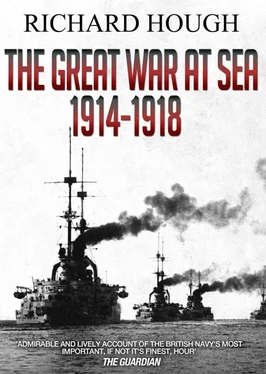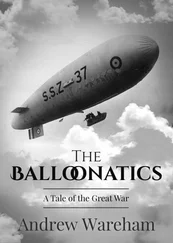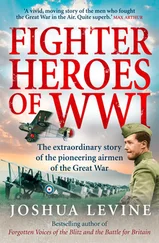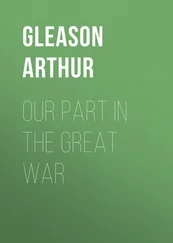Churchill under the influence of Fisher, the submarine’s most ardent advocate, a small number of intelligent and far-sighted senior officers, and politicians, supported the submarine branch and the construction of more submarines and new long-range torpedoes. As early as January 1912 he was in earnest correspondence with a number of politicians about the influence of the modern submarine and torpedo on the nation’s defensive as well as offensive plans. Arthur Balfour, recently Prime Minister (1902-5) and destined to succeed Churchill as First Lord. was especially encouraging. ‘I have been thinking over what you wrote about submarines,’ Churchill wrote to him. ‘They seem to me a great advantage to us. They make invasion look more difficult than before. They are the most formidable defence for their own coasts… On balance we are the gainers of this new type [of submarine]… Another thing which properly employed will be helpful to us is the long range torpedo. 10,000 yards! And it is a mere calculation of odds to see how many must be fired from one line of ships at another to hit every vessel – bar accidents.’
Balfour replied that he entirely agreed. ‘I have long been strongly of the opinion that submarines will modify the whole question of Home Defence’, he answered.’ (13)
By 1912 the size, range, and power of the submarine had much increased and its influence on manoeuvres could only be denied by blinkered officers, which unfortunately included a majority of the Board. In the 1913 manoeuvres submarine officers claimed to have accounted for 40 per cent of the men o’war present, in spite of the rule that after making a claim the submarine was obliged to surface for half an hour and not attack any vessel within three miles, in simulation of what were judged to be real-war conditions.
Nonetheless, under Churchill’s regime the submarine was rapidly developed. The E-class which was to play such an important part in the war, was a vessel 178 feet long with a radius of action of 4,000 miles, a surface speed of over 15 knots and submerged speed of almost 10 knots. No one could totally disregard the threat of a swarm of such vessels on a battle fleet in misty typical North Sea weather. Recognition of the threat from German U-boats was reflected in the fundamental and highly secret strategical decision taken in 1912 to cancel a close blockade of the German coast in the naval war plans and substitute distant blockade. In debates inside and outside the Admiralty in the months leading to war the submarine threat was argued exhaustively. Even the possibility of having to keep the dreadnought fleet out of the North Sea altogether because of what was euphemistically termed ‘the small-craft menace’ was aired.
Admiral Sir Percy Scott, a figure almost as dynamic, controversial, and far-seeing as Fisher (but lacking his charm and wiliness), and a revolutionary figure in the field of naval gunnery, contributed an article to The Times a few weeks before war was declared arguing that the Fleet of the future would require only aircraft and submarines. ‘Submarines and aeroplanes have entirely revolutionized naval warfare; no feet can hide itself from the aeroplane’s eye, and the submarine can deliver a deadly attack even in broad daylight.’ (14)
The outraged chorus of protests at this suggestion included the voices of all those of conservative inclination and with vested interest in the continued paramountcy of the dreadnought, from shipbuilders and steel-plate manufacturers to most officers serving in the Fleet. Scott’s modest weight of supporters included the Liberal Press which saw in his argument a means of reducing the crippling cost of armaments.
Nevertheless the threat of the submarine was taken seriously enough for an Admiralty Submarine Committee to be set up to consider proposals for weapons to counter the menace. It remained barren of ideas. ‘It is high time’, declared one admiral at a War College lecture in April 1914, ‘we put the fear of God into these young gentlemen who lie about the North Sea attacking all and sundry without let or hindrance.’ How this was to be accomplished remained for the present unanswered.
The hard prejudice which hindered the development of the submarine did not apply to naval aviation. It is true that when offered the Wright brothers’ patent in 1907 Lord Tweedmouth on behalf of the Board had turned it down. But two years later when the Hon. C. S. Rolls of the infant Rolls-Royce motor car company offered the Government the use of his Wright aeroplane he used for recreation, it was gladly accepted. Before he resigned Fisher was showing interest on behalf of the Admiralty and had ordered the construction of an airship. As soon as Churchill was appointed, Fisher determined that the subject should not be allowed to drop. ‘ Aviation supersedes small cruisers & Intelligence vessels. You told me you would push aviation …’ (15)
Churchill himself needed no pushing. From the first he was an enthusiastic supporter of early experiments and, in the teeth of Treasury opposition, put an Air Department to work. Soon he was able to write to Fisher. ‘Aviation is going ahead. In a few months the Navy List will contain regular flights of aeroplanes attached to the battle squadrons.’ (16)There was little or no opposition within the service. The aeroplane and airship were proving useful for scouting, for observing the fall of shot in action as well as locating submerged submarines and minefields. They were seen as an aid to and not a threat to the battleship.
In Germany, under the inspiration of Count Ferdinand von Zeppelin and with the support of Tirpitz, the lighter-than-air machine was favoured, and before war broke out the German Navy could call on a powerful force of some twenty highly reliable and effective Zeppelins based on Cuxhaven. Churchill respected this force but determined that the Royal Navy should concentrate on the aeroplane which was less vulnerable, cheaper, more adaptable and could be flown off the water on floats or carried in seaplane-carriers.
At Eastchurch on the Thames estuary a small but efficient naval air arm came into being. In 1913 the Hermes , the world’s first aircraft (seaplane) carrier, was commissioned. The enthusiastic pilots and some admirals (Wilson, surprisingly, was among them) saw an important and wider future for aircraft. By 1914 plans were already being made for seaplanes to carry a charge of gun cotton fused to explode close to submerged submarines. An article in a service magazine in the same year drew the attention of its readers to aircraft as future torpedo carriers.’ (17)
Amidst the mass of work for which Churchill had made himself responsible outside as well as inside the Admiralty, he made a study of the new machines in the greatest detail. He took lessons in flying and was thus able to correct with authority what he regarded as detail flaws, such as inferior seating and flimsy controls. Charles Rolls had already become the first flying fatality and others had been killed or injured. Churchill’s wife and his fellow politicians and friends begged him to desist. He was about to solo when his own instructor was killed and this led him at last to give it up, though with many regrets.
It was typical of Churchill that he regarded the detail of his work as important as the broad sweep of policy. After two years of his insistence, for example, on examining the working of a submarine’s periscope or a Barr and Stroud range-finder, the cooking equipment at Dartmouth naval college, or the functioning of the feed equipment in a new fleet tanker, the Navy gave up taking offence and (as the German naval attaché had learned) Churchill was generally treated with respect and admiration.
Gunnery and fire control was one of the largest and most important subjects to come under his critical eye. Percy Scott had for long been concerned at the shortcomings, which could prove fatal under certain conditions, of the practice of individual gunlayers and trainers being responsible for the accuracy of their own gun or guns. With the increase in range of modern gunnery, Scott contended that the gunlayer in action at his relatively low station might well be so blinded by smoke, haze, spume, shell splash, and mist that he might not fire’ on the correct target, let alone hit it.
Читать дальше












